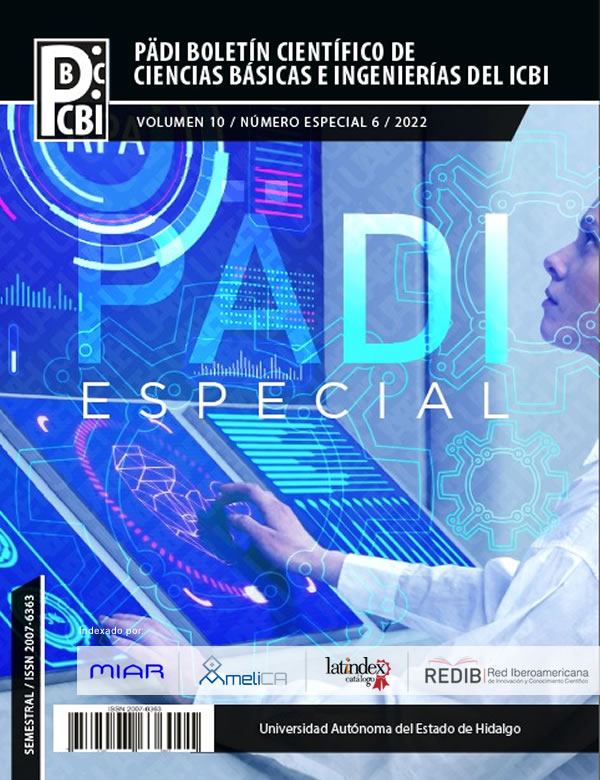Instrumentación de un prototipo transtibial para replicar el ciclo de marcha en tobillo
Resumen
El presente trabajo describe la instrumentación eléctrica y electrónica de un prototipo protésico diseñadopara una amputación transtibial a nivel del tercio superior, la instrumentación propuesta se integra a un
mando central que tiene como elemento principal a un microprocesador Raspberry Pi Zero W. El prototipo
cuenta con características mínimas viables que le permiten reproducir el movimiento del tobillo durante el
ciclo de marcha. Para validar la instrumentación propuesta, se hace uso de una máquina de estados y un
controlador tipo PD, ambos se implementaron de forma embebida en el microprocesador mediante el uso de un
lenguaje multiplataforma de código abierto. Por último, se muestran los resultados del seguimiento
de la trayectoria del tobillo durante el ciclo de marcha.
Descargas
Citas
Arredondo, G. P. (2013). Amputaciones en un hospital general en pacientes con pie diabético, análisis de tres años. amputations in a general hospital in patients with diabetic foot, three-years analysis. Revista Salud Quintana Roo.
Bartlett, H. L., Lawson, B. E., and Goldfarb, M. (2019). Design, control, and preliminary assessment of a multifunctional semipowered ankle prosthesis. IEEE/ASME Transactions on Mechatronics, 24(4):1532–1540.
Cantalapiedra, A. A., Gelabert, C. J. A., and Bacallao, Y. G. (2016). Protocolo de actuación en la rehabilitación de pacientes amputados de miembro inferior. Revista Cubana de Medicina Física y Rehabilitación, 8(1):33–43.
Castillo-Guzmán, S., Palacios-Ríos, D., López-Cabrera, N. G., Hernández-Guedea, M. A., Rodríguez-Rodríguez, N. H., and González-Santiago, O. (2018). Variación estacional de las amputaciones en un hospital universitario de monterrey, México (2009-2012). Cirugía y cirujanos, 86(5):399–403.
Chang, M., Kim, K., and Jeon, D. (2019). Research on terrain identification of the smart prosthetic ankle by fuzzy logic. IEEE Transactions on Neural Systems and Rehabilitation Engineering, 27(9):1801–1809.
Cisneros-González, N., de Jesús Ascencio-Montiel, I., Libreros-Bango, V. N., Rodríguez-Vázquez, H., Campos-Hernández, A., Dávila-Torres, J., Kumate-Rodríguez, J., and Borja-Aburto, V. H. (2016). Índice de amputaciones de extremidades inferiores en pacientes con diabetes. Revista Médica del Instituto Mexicano del Seguro Social, 54(4):472–479.
Czerwinski, R. and Kania, D. (2013). Finite state machine logic synthesis for complex programmable logic devices, volume 231. Springer Science & Business Media.
David Hazzel Mozo Galvez, Marcos Alvarado Bastida, J. A. G. G. (2019). Instrumentación de un prototipo transfemoral para seguimiento de trayectoria de rodilla y tobillo. Tesis de licenciatura, Escuela Superior de Ingeniería Mecánica y Eléctrica, Instituto Politécnico Nacional.
Dobson, A., Wei, G., and Ren, L. (2019). Biologically inspired design and development of a variable stiffness powered ankle-foot prosthesis. Journal of Mechanisms and Robotics, 11.
Dong, D., Ge, W., Convens, B., Sun, Y., Verstraten, T., and Vanderborght, B. (2020). Design, optimization and energetic evaluation of an efficient fully powered ankle-foot prosthesis with a series elastic actuator. IEEE Access, PP.
Ficanha, E. M., Rastgaar, M., and Kaufman, K. R. (2015). Control of a 2-dof powered ankle-foot mechanism. In 2015 IEEE International Conference on Robotics and Automation (ICRA), pages 6439–6444. IEEE.
Götz-Neumann, K. (2006). Gehen verstehen: Ganganalyse in der Physiotherapie; 18 Tabellen. Georg Thieme Verlag.
Grimmer, M., Holgate, M., Holgate, R., Boehler, A., Ward, J., Hollander, K., Sugar, T., and Seyfarth, A. (2016). A powered prosthetic ankle joint for walking and running. Biomedical engineering online, 15(3):37–52.
Herr, H. M.,Weber, J. A., Au, K.W. S., Deffenbaugh, B.W., Magnusson, L. H., Hofmann, A. G., and Aisen, B. B. (2018). Powered ankle-foot prosthesis. US Patent 10,137,011.
INEGI (2021). Censo de población y vivienda 2020. COMUNICADO DE PRENSA NUM 24/21.
Koehler-McNicholas, S. R., Nickel, E. A., Medvec, J., Barrons, K., Mion, S., and Hansen, A. H. (2017a). The influence of a hydraulic prosthetic ankle on residual limb loading during sloped walking. PloS one, 12(3):e0173423.
Koehler-McNicholas, S. R., Nickel, E. A., Medvec, J., Barrons, K., Mion, S., and Hansen, A. H. (2017b). The influence of a hydraulic prosthetic ankle on residual limb loading during sloped walking. PloS one, 12(3):e0173423.
Lenzi, T., Cempini, M., Newkirk, J., Hargrove, L. J., and Kuiken, T. A. (2017). A lightweight robotic ankle prosthesis with non-backdrivable cam-based transmission. In 2017 International Conference on Rehabilitation Robotics (ICORR), pages 1142–1147. IEEE.
Merlo, A., Farina, D., and Merletti, R. (2003). A fast and reliable technique for muscle activity detection from surface emg signals. IEEE transactions on biomedical engineering, 50(3).
Microchip (2008). Mcp3004/3008 , 2.7v 4-channel/8-channel 10-bit a/d converters with spi serial interface. Technical report, Microchip Technology Inc.
Montealegre, L. C. D. (2016). Prótesis electrónicas: Una nueva esperanza para mejorar la calidad de vida de las personas. Informador técnico, 80(2).
Mora, M. (2016). Ingresos de los hogares por nivel socioecon´omico. Ranka, 17.
Negi, S., Sagar, U., Nautiyal, V. K., and Sharma, N. (2021). Design and analysis of magnetorheological damper based ankle-foot prosthesis prototype. Industrial Robot: the international journal of robotics research and application.
Perry, J., Davids, J. R., et al. (1992). Gait analysis: normal and pathological function, volume 12. LWW.
Pina Filho, A. C. and Dutra, M. (2013). Modelling of the human ankle by means of a nonlinear oscillators system.
Rezazadeh, S., Quintero, D., Divekar, N., Reznick, E., Gray, L., and Gregg, R. D. (2019). A phase variable approach for improved rhythmic and non-rhythmic control of a powered knee-ankle prosthesis. IEEE Access, 7:109840–109855.
Sadun, A., Jalani, J., and Sukor, J. (2016). Force sensing resistor (fsr): a brief overview and the low-cost sensor for active compliance control. page 1001112.
Sánchez, E. V. V. (2016). Los amputados y su rehabilitación. Un reto para el Estado. Academia Nacional de Medicina. México.
Serrano, H. L. (2015). Diseño y construcción de una prótesis activa de tobillo utilizando amortiguamiento semi-activo. Master’s thesis, Instituto Politécnico Nacional, Unidad Profesional Interdisciplinaria en Ingeniería y Tecnologías Avanzadas.
SERVOCITY (2014). 2”stroke 180 lb thrust heavy duty linear actuator- hda2-30. Technical report, SERVOCITY.
STMicroelectronics (2013). Vnh2sp30-e / automotive fully integrated h-bridge motor driver. Technical report, STMicroelectronics.
Vaughan, C., Davis, B., and OConnor, J. (1999). Dynamics of human gait. Kiboho Publishers Cape Town South Africa.












